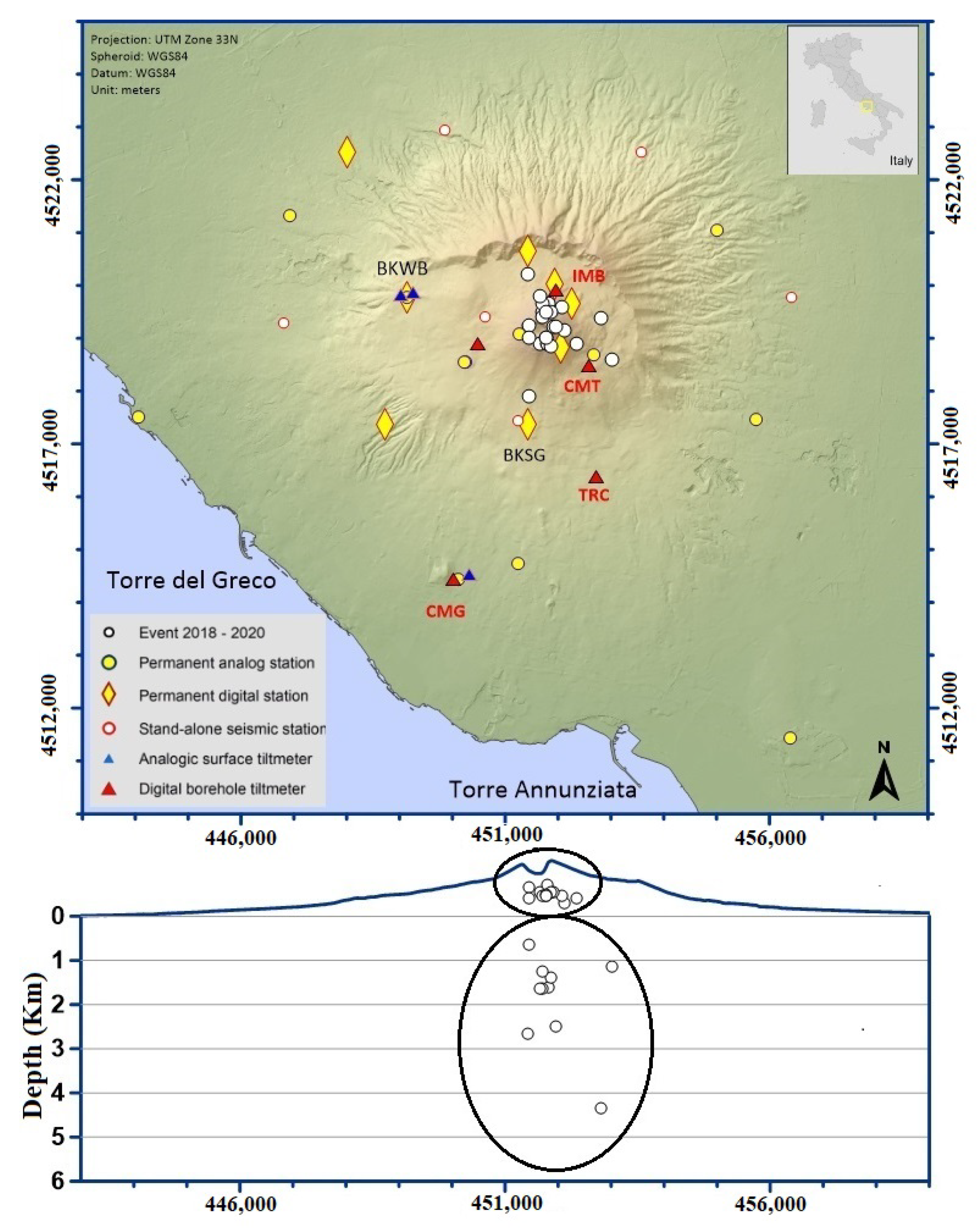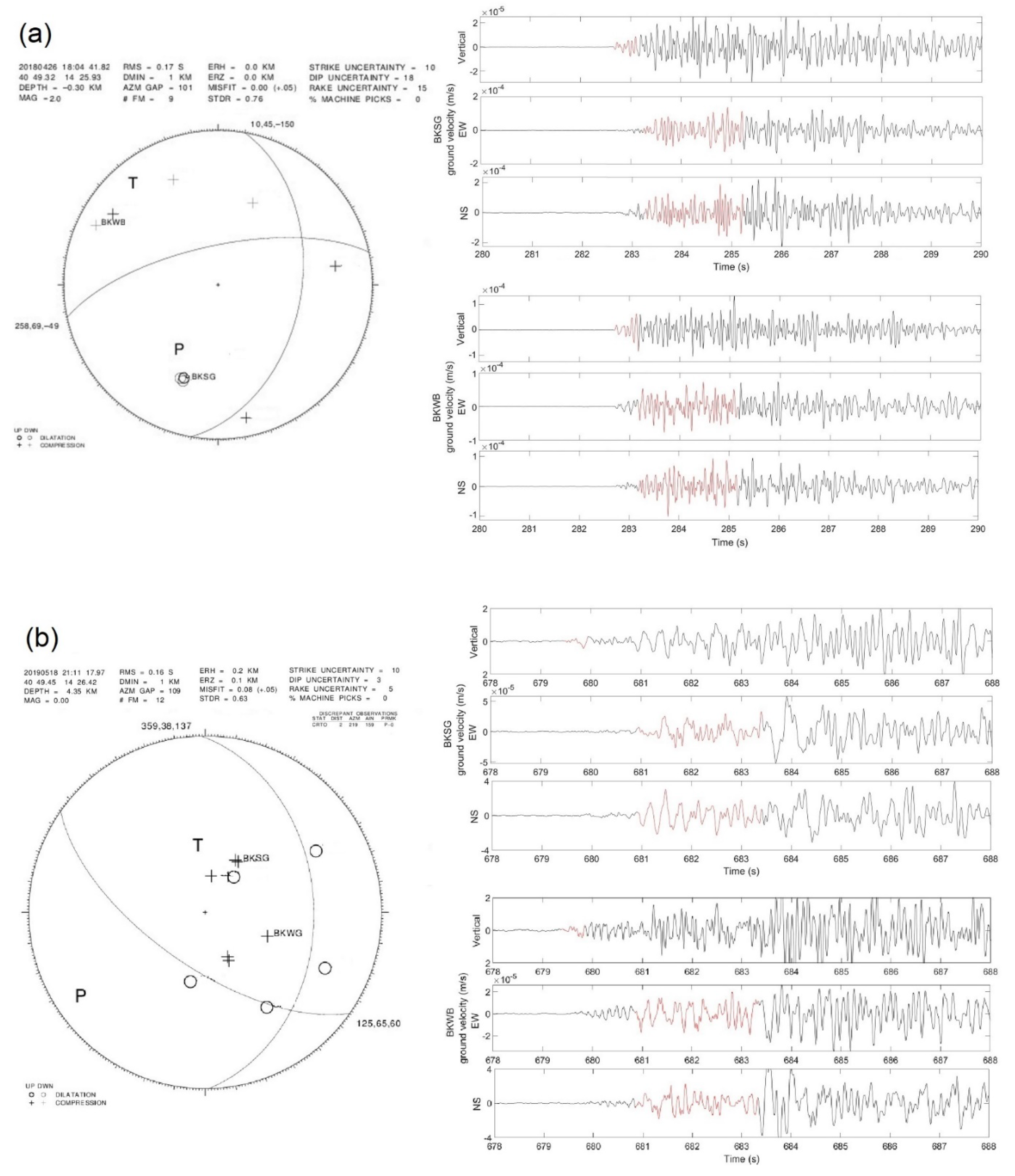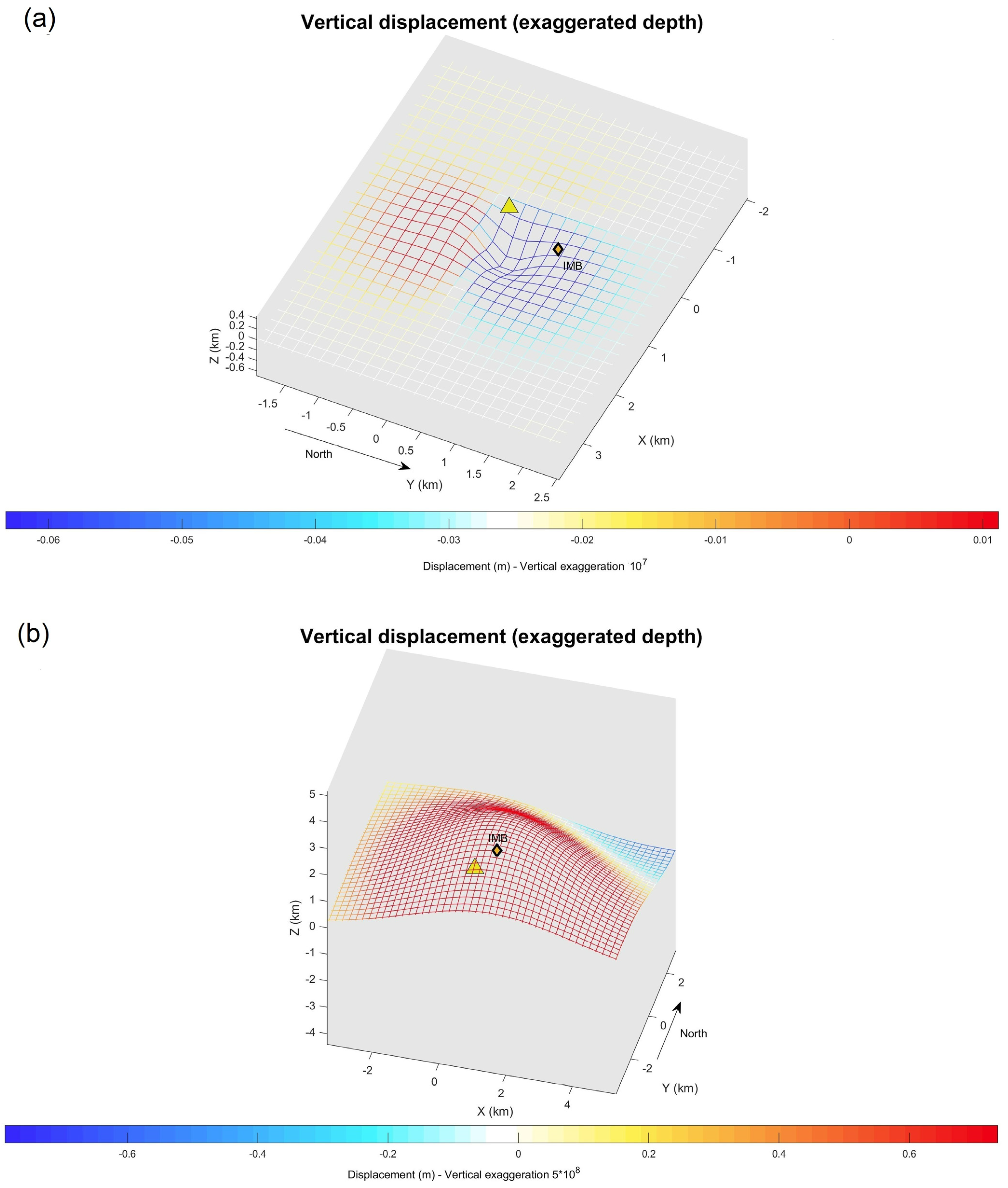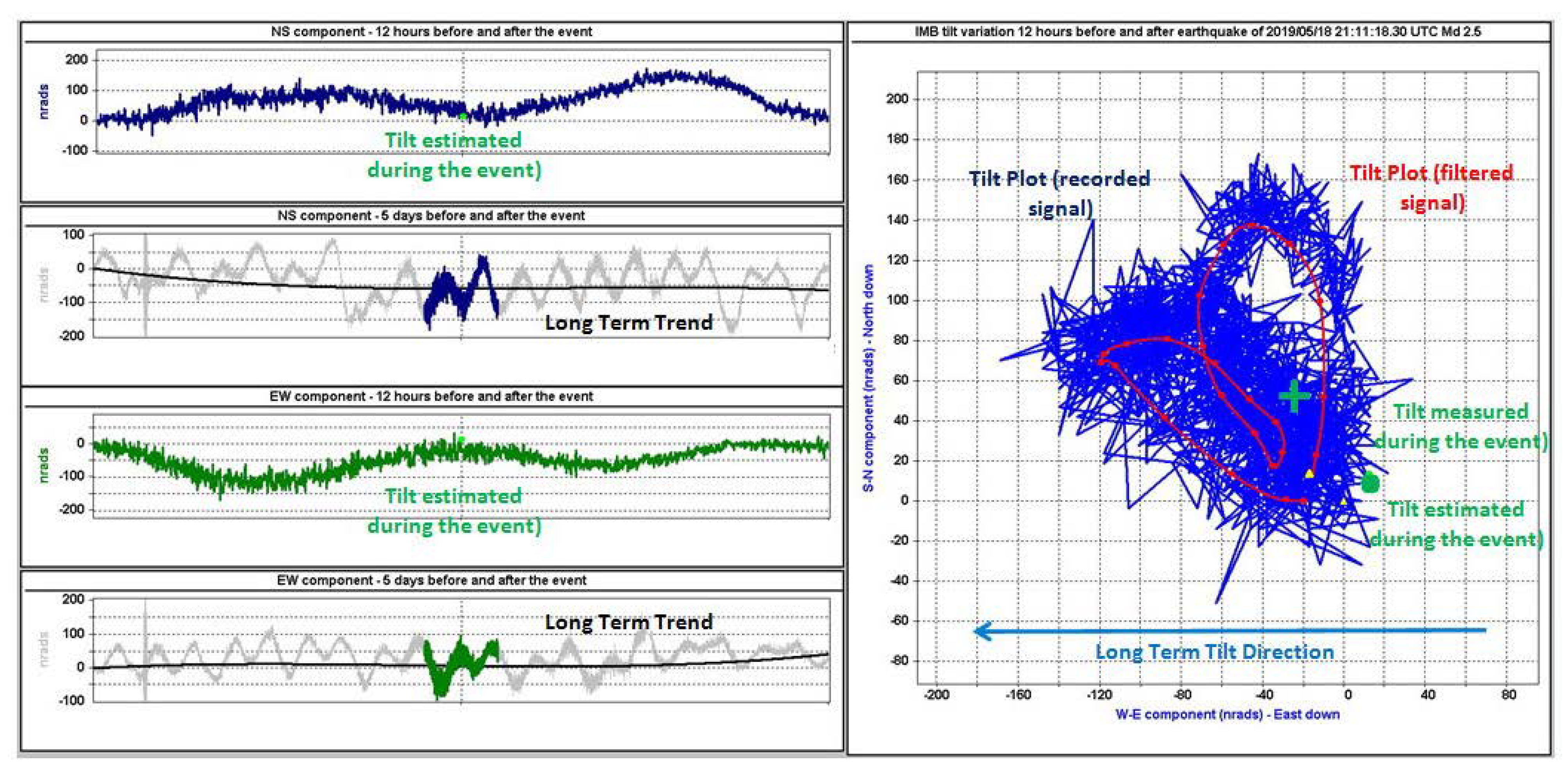A First Step towards the Definition of a Link between Ground Tilt and Earthquakes at Mt. Vesuvius (Italy)
Abstract
1. Introduction
2. Materials and Methods
2.1. Seismic Data
2.2. Seismological Methods: Focal Mechanism, Source Spectra and Static Displacement
2.3. Ground Tilt Data
2.4. Tiltmeter Methods: Ground Tilt Calculation from Displacement
3. Results
3.1. Seismological Results
3.2. Tiltmeter Results
4. Discussion and Conclusions
Author Contributions
Funding
Institutional Review Board Statement
Informed Consent Statement
Data Availability Statement
Acknowledgments
Conflicts of Interest
References
- Ricco, C.; Petrosino, S.; Aquino, I.; Cusano, P.; Madonia, P. Tracking the recent dynamics of Mt. Vesuvius from joint investigations of ground deformation, seismicity and geofluid circulation. Sci. Rep. 2021, 11, 965. [Google Scholar] [CrossRef] [PubMed]
- Madonia, P.; Federico, C.; Cusano, P.; Petrosino, S.; Aiuppa, A.; Gurrieri, S. Crustal dynamics of Mount Vesuvius from 1998 to 2005: Effects on seismicity and fluid circulation. J. Geophys. Res. Earth Surf. 2008, 113, 1–12. [Google Scholar] [CrossRef]
- Piochi, M.; Bruno, P.P.; De Astis, G. Relative roles of rifting tectonics and magma ascent processes: Inferences from geophysical, structural, volcanological, and geochemical data for the Neapolitan volcanic region (southern Italy). Geochem. Geophys. Geosystems 2005, 6, 1–25. [Google Scholar] [CrossRef]
- Petrosino, S.; Ricco, C.; Aquino, I. Modulation of Ground Deformation and Earthquakes by Rainfall at Vesuvius and Campi Flegrei (Italy). Front. Earth Sci. 2021, 9, 758602. [Google Scholar] [CrossRef]
- Voight, B.; Hoblitt, R.P.; Clarke, A.B.; Lockhart, A.B.; Miller, A.D.; Lynch, L.; McMahon, J. Remarkable cyclic ground deformation monitored in real-time on Montserrat, and its use in eruption forecasting. Geophys. Res. Lett. 1998, 25, 3405–3408. [Google Scholar] [CrossRef]
- Genco, R.; Ripepe, M. Inflation-deflation cycles revealed by tilt and seismic records at Stromboli volcano. Geophys. Res. Lett. 2010, 37, L12302. [Google Scholar] [CrossRef]
- Honda, R.; Yukutake, Y.; Morita, Y.; Sakai, S.; Itadera, K.; Kokubo, K. Precursory tilt changes associated with a phreatic eruption of the Hakone volcano and the corresponding source model. Earth, Planets Space 2018, 70, 117. [Google Scholar] [CrossRef]
- Ricco, C.; Petrosino, S.; Aquino, I.; Del Gaudio, C.; Falanga, M. Some Investigations on a Possible Relationship between Ground Deformation and Seismic Activity at Campi Flegrei and Ischia Volcanic Areas (Southern Italy). Geosciences 2019, 9, 222. [Google Scholar] [CrossRef]
- Bianco, F.; Castellano, M.; Milano, G.; Ventura, G.; Vilardo, G. The Somma–Vesuvius stress field induced by regional tectonics: Evidences from seismological and mesostructural data. J. Volcanol. Geotherm. Res. 1998, 82, 199–218. [Google Scholar] [CrossRef]
- Ventura, G.; Vilardo, G. Slip tendency analysis of the Vesuvius Faults: Implications for the seismotectonic and volcanic hazard assessment. Geophys. Res. Lett. 1999, 26, 3229–3232. [Google Scholar] [CrossRef]
- D’Auria, L.; Massa, B.; De Matteo, A. The stress field beneath a quiescent stratovolcano: The case of Mount Vesuvius. J. Geophys. Res. Solid Earth 2014, 119, 1181–1199. [Google Scholar] [CrossRef]
- Bellucci Sessa, E.; Borriello, G.; Cirillo, F. NAPLES (moNitoring mAps of camPania voLcanoES). 2022. Available online: https://zenodo.org/record/5886962 (accessed on 4 February 2022).
- Zollo, A.; Marzocchi, W.; Capuano, P.; Lomax, A.; Iannaccone, G. Space and Time Behavior of Seismic Activity at Mt. Vesuvius Volcano, Southern Italy. Bull. Seism. Soc. Am. 2002, 92, 625–640. [Google Scholar] [CrossRef]
- Del Pezzo, E.; Bianco, F.; Saccorotti, G. Seismic source dynamics at Vesuvius volcano, Italy. J. Volcanol. Geotherm. Res. 2004, 133, 23–39. [Google Scholar] [CrossRef]
- Caliro, S.; Chiodini, G.; Avino, R.; Minopoli, C.; Bocchino, B. Long time-series of chemical and isotopic compositions of Vesuvius fumaroles: Evidence for deep and shallow processes. Ann. Geophys. 2011, 54, 137–149. [Google Scholar] [CrossRef]
- Bianco, F.; Cusano, P.; Petrosino, S.; Buonocunto, C.; Castellano, M.; Capello, M.; Del Pezzo, E. Small-aperture Array for Seismic Monitoring of Mt. Vesuvius. Seism. Res. Lett. 2005, 76, 334–355. [Google Scholar] [CrossRef]
- Petrosino, S.; Cusano, P. Low frequency seismic source investigation in volcanic environment: The Mt. Vesuvius atypical case. Adv. Geosci. 2020, 52, 29–39. [Google Scholar] [CrossRef]
- Galluzzo, D.; Nardone, L.; La Rocca, M.; Esposito, A.M.; Manzo, R.; Di Maio, R. Statistical moments of power spectrum: A fast tool for the classification of seismic events recorded on volcanoes. Adv. Geosci. 2020, 52, 67–74. [Google Scholar] [CrossRef]
- Ricco, C.; Aquino, I.; Borgstrom, I.B.S.; Del Gaudio, C. 19 years of tilt data on Mt. Vesuvius: State of the art and future perspectives. Ann. Geophys. 2013, 56, S0453. [Google Scholar] [CrossRef]
- Borgia, A.; Tizzani, P.; Solaro, G.; Manzo, M.; Casu, F.; Luongo, G.; Pepe, A.; Berardino, P.; Fornaro, G.; Sansosti, E.; et al. Volcanic spreading of Vesuvius, a new paradigm for interpreting its volcanic activity. Geophys. Res. Lett. 2005, 32, L03303. [Google Scholar] [CrossRef]
- Galluzzo, D.; Del Pezzo, E.; La Rocca, M.; Petrosino, S. Peak ground acceleration produced by local earthquakes in volcanic areas of Campi Flegrei and Mt. Vesuvius. Ann. Geophys. 2004, 47, 1377–1389. [Google Scholar] [CrossRef]
- Galluzzo, D.; Del Pezzo, E.; La Rocca, M.; Castellano, M.; Bianco, F. Source Scaling and Site Effects at Vesuvius Volcano. Bull. Seism. Soc. Am. 2009, 99, 1705–1719. [Google Scholar] [CrossRef]
- Lin, J.; Stein, R.S. Stress triggering in thrust and subduction earthquakes and stress interaction between the southern San Andreas and nearby thrust and strike-slip faults. J. Geophys. Res. Solid Earth 2004, 109, B02303. [Google Scholar] [CrossRef]
- Toda, S.; Stein, R.S.; Sevilgen, V.; Lin, J. Coulomb 3.3 Graphic-Rich Deformation and Stress-Change Software for Earthquake, Tectonic, and Volcano Research and Teaching-User Guide. 2011. Available online: https://pubs.usgs.gov/of/2011/1060/ (accessed on 27 December 2021).
- La Rocca, M.; Galluzzo, G. Seismic monitoring of Campi Flegrei and Vesuvius by stand-alone instruments. Ann. Geophys. 2015, 58, S0544. [Google Scholar] [CrossRef]
- Orazi, M.; D’Auria, L.; Tramelli, A.; Buonocunto, C.; Capello, M.; Caputo, A.; De Cesare, W.; Giudicepietro, F.; Martini, M.; Peluso, R.; et al. The seismic monitoring network of Mt. Vesuvius. Ann. Geophys. 2013, 56, S0450. [Google Scholar] [CrossRef]
- Lo Bascio, D.; Ricciolino, P. Cataloghi Sismici Dei Vulcani Campani. Stazione OVO Vesuvio dal 1972 al 2021 (Version 1.0); Istituto Nazionale di Geofisica e Vulcanologia (INGV): Rome, Italy, 2021. [CrossRef]
- Reasenberg, P.A.; Oppenheimer, D. FPFIT, FPPLOT, and FPPAGE: Fortran Computer Programs for Calculating and Displaying Earthquake Fault-Plane Solutions 1985. Available online: https://pubs.er.usgs.gov/publication/ofr85739 (accessed on 22 October 2021).
- Lomax, A.; Virieux, J.; Volant, P.; Berge, C. Probabilistic Earthquake Location in 3D and Layered Models: Introduction of a Metropolis-Gibbs method and comparison with linear locations. In Advances in Seismic Event Location; Thurber, C.H., Rabinowitz, N., Eds.; Kluwer: Dordrecht, The Netherlands, 2000; pp. 101–134. [Google Scholar] [CrossRef]
- Lay, T.; Wallace, T.C. Modern Global Seismology; Academic Cambridge Press: London, UK, 1995. [Google Scholar]
- Aki, K.; Richards, P. Quantitative Seismology: Theory and Methods; Freeman: San Francisco, CA, USA, 1980. [Google Scholar]
- Okada, Y. Internal deformation due to shear and tensile faults in a half-space. Bull. Seism. Soc. Am. 1992, 82, 1018–1040. [Google Scholar] [CrossRef]
- MathWorks Inc. MATLAB 1994–2022. Available online: https://it.mathworks.com/products/matlab.html (accessed on 24 February 2022).
- Battaglia, M.; Cervelli, P.; Murray, J. Modeling of Volcanic Processes. In Modeling Crustal Deformation near Active Faults and Volcanic Centers—A Catalog of Deformation Models; CreateSpace Independent Publishing Platform: Scotts Valley, CA, USA, 2013. [Google Scholar]
- Lomax, A.; Zollo, A.; Capuano, P.; Virieux, J. Precise, absolute earthquake location under Somma–Vesuvius volcano using a new 3D velocity model. Geophys. J. Int. 2001, 146, 313–331. [Google Scholar] [CrossRef]
- Iannaccone, G.; Alessio, G.; Borriello, G.; Cusano, P.; Petrosino, S.; Ricciolino, P.; Talarico, G.; Torello, V. Characteristics of the seismicity of Vesuvius and Campi Flegrei during the year 2000. Ann. Geophys. 2009, 44, 1075–1091. [Google Scholar] [CrossRef]
- Tammaro, U.; Riccardi, U.; Romano, V.; Meo, M.; Capuano, P. Topography and structural heterogeneities in surface ground deformation: A simulation test for Somma-Vesuvius volcano. Adv. Geosci. 2021, 52, 145–152. [Google Scholar] [CrossRef]
- Aloisi, M.; Mattia, M.; Monaco, C.; Pulvirenti, F. Magma, faults, and gravitational loading at Mount Etna: The 2002–2003 eruptive period. J. Geophys. Res. Earth Surf. 2011, 116, B05203. [Google Scholar] [CrossRef]
- Wyatt, F.; Cabaniss, G.; Agnew, D.C. A comparison of tiltmeters at tidal frequencies. Geophys. Res. Lett. 1982, 9, 743–746. [Google Scholar] [CrossRef]






| Origin Time (yyyymmdd hh:MM s) | Latitude N (deg min) | Longitude E (deg min) | Depth 1 (km) | MD | Strike 2 | Dip 3 | Rake 4 |
|---|---|---|---|---|---|---|---|
| 20180426 18:04 41.82 | 40 49.32 | 14 25.93 | −0.30 | 2.1 | 10 | 45 | −150 |
| 20180509 21:58 07.67 | 40 49.18 | 14 25.60 | −0.55 | 2.3 | 50 | 70 | 80 |
| 20180522 15:37 35.16 | 40 49.59 | 14 25.71 | 1.60 | 2.3 | 75 | 70 | 140 |
| 20180816 13:14 09.37 | 40 49.56 | 14 25.89 | −0.45 | 2.2 | 55 | 65 | 40 |
| 20181016 01:07 14.13 | 40 49.18 | 14 25.71 | −0.70 | 2.5 | 75 | 80 | 130 |
| 20181129 15:55 12.46 | 40 49.51 | 14 25.64 | 1.65 | 2.3 | 155 | 10 | −40 |
| 20181201 10:11 08.91 | 40 49.51 | 14 25.75 | 1.40 | 2.2 | 0 | 35 | −140 |
| 20181202 19:09 18.57 | 40 49.59 | 14 25.64 | 1.25 | 2.5 | 145 | 30 | −50 |
| 20181202 23:42 50.50 | 40 49.67 | 14 25.60 | 1.65 | 2.5 | 240 | 80 | 140 |
| 20181209 12:24 29.68 | 40 49.18 | 14 26.10 | −0.40 | 2.1 | 20 | 40 | 0 |
| 20190518 21:11 17.97 | 40 49.45 | 14 26.42 | 4.35 | 2.5 | 125 | 65 | 60 |
| 20190816 20:15 44.17 | 40 49.18 | 14 25.71 | −0.50 | 2.1 | 15 | 45 | −140 |
| 20200115 18:43 52.03 | 40 49.02 | 14 26.57 | 1.15 | 2.3 | 170 | 50 | −50 |
| 20200213 19:14 44.50 | 40 49.89 | 14 25.43 | 2.65 | 2.2 | 5 | 70 | −80 |
| 20200319 03:48 07.16 | 40 49.24 | 14 25.68 | −0.45 | 2.4 | 285 | 85 | 10 |
| 20200424 00:17 04.71 | 40 49.37 | 14 25.46 | −0.65 | 2.3 | 15 | 60 | −140 |
| 20200427 04:47 38.01 | 40 49.35 | 14 25.78 | −0.55 | 2.1 | 240 | 85 | −40 |
| 20200708 23:51 31.15 | 40 49.24 | 14 25.46 | −0.40 | 2.1 | 145 | 25 | −50 |
| 20200720 05:57 59.21 | 40 49.45 | 14 25.64 | −0.45 | 2.2 | 325 | 65 | 20 |
| 20200803 02:07 05.46 | 40 49.16 | 14 25.75 | −0.55 | 2.3 | 60 | 35 | 0 |
| 20200811 17:53 49.48 | 40 49.35 | 14 25.82 | 2.50 | 2.0 | 170 | 35 | 20 |
| 20200902 01:16 27.19 | 40 49.24 | 14 25.68 | −0.50 | 2.1 | 80 | 30 | 10 |
| 20200923 21:45 51.88 | 40 48.64 | 14 25.46 | 0.65 | 2.3 | 65 | 90 | −20 |
| 20201122 23:39 32.08 | 40 49.51 | 14 25.68 | −0.45 | 2.1 | 20 | 35 | 0 |
| Grid Parameters | Value (km) |
|---|---|
| Start-x | −6.5 |
| Start-y | −5.0 |
| Finish-x | 6.5 |
| Finish-y | 5.0 |
| x-increment | 0.2 |
| y-increment | 0.2 |
| Size Parameters | Value |
| Plot size | 2.0 |
| Shade/Color increment | 2.0 |
| Exaggeration for disp.& dist. | 5,000,000.00 |
| Cross section default | Value (km) |
| Start-x | −6.5 |
| Start-y | −5.0 |
| Finish-x | 6.5 |
| Finish-y | 5.0 |
| Distant-increment | 0.5 |
| Z-depth | 5.0 |
| Z-increment | 0.25 |
| Map info (°) | value |
| min. lon | 14.3482406 |
| max. lon | 14.5016126 |
| zero lon | 14.4248700 |
| min. lat | 40.7751370 |
| max. lat | 40.8659860 |
| zero lat | 40.8205900 |
| Earthquakes | Depth (km) | MD | IMB | CMT | TRC | CMG | |
|---|---|---|---|---|---|---|---|
| 1 | 20180426 | −0.30 | 2.1 | LTC | LTC | TF | TF |
| 2 | 20180509 | −0.55 | 2.3 | LTC | LTC | TF | TF |
| 3 | 20180522 | 1.60 | 2.3 | LTC | NC | LTC | TF |
| 4 | 20180816 | −0.45 | 2.2 | No VT and Tilt data | No VT data | No VT and Tilt data | No VT data |
| 5 | 20181016 | −0.70 | 2.5 | No Tilt data | LTC | TF | TF |
| 6 | 20181129 | 1.65 | 2.3 | No Tilt data | LTC | LTC although TF | LTC |
| 7 | 20181201 | 1.40 | 2.2 | No Tilt data | NC | LTC | TF |
| 8 | 20181202 | 1.25 | 2.5 | No Tilt data | NC | LTC | LTC |
| 9 | 20181202 | 1.65 | 2.5 | No Tilt data | LTC | LTC | LTC |
| 10 | 20181209 | −0.40 | 2.1 | LTC | LTC | TF | TF |
| 11 | 20190518 | 4.35 | 2.5 | LTC | LTC | LTC | LTC |
| 12 | 20190816 | −0.50 | 2.1 | NC | LTC | TF | TF |
| 13 | 20200115 | 1.15 | 2.3 | LTC | LTC | LTC | LTC |
| 14 | 20200213 | 2.65 | 2.2 | NC | LTC | LTC | LTC unclear |
| 15 | 20200319 | −0.45 | 2.4 | LTC | LTC | TF | LTC although TF |
| 16 | 20200424 | −0.65 | 2.3 | LTC | TF | TF | TF |
| 17 | 20200427 | −0.55 | 2.1 | LTC | LTC although TF | TF | LTC although TF |
| 18 | 20200708 | −0.40 | 2.1 | NC | LTC | TF | TF |
| 19 | 20200720 | −0.45 | 2.2 | LTC | LTC | TF | TF |
| 20 | 20200803 | −0.55 | 2.3 | TF | LTC | TF | TF |
| 21 | 20200811 | 2.50 | 2.0 | LTC | LTC | LTC | NC |
| 22 | 20200902 | −0.50 | 2.1 | TF | LTC unclear | TF | TF |
| 23 | 20200923 | 0.65 | 2.3 | LTC | LTC | NC | TF |
| 24 | 20201122 | −0.45 | 2.1 | LTC | TF | TF | TF |
Publisher’s Note: MDPI stays neutral with regard to jurisdictional claims in published maps and institutional affiliations. |
© 2022 by the authors. Licensee MDPI, Basel, Switzerland. This article is an open access article distributed under the terms and conditions of the Creative Commons Attribution (CC BY) license (https://creativecommons.org/licenses/by/4.0/).
Share and Cite
Cusano, P.; Ricco, C.; Aquino, I.; Petrosino, S. A First Step towards the Definition of a Link between Ground Tilt and Earthquakes at Mt. Vesuvius (Italy). Appl. Sci. 2022, 12, 12261. https://doi.org/10.3390/app122312261
Cusano P, Ricco C, Aquino I, Petrosino S. A First Step towards the Definition of a Link between Ground Tilt and Earthquakes at Mt. Vesuvius (Italy). Applied Sciences. 2022; 12(23):12261. https://doi.org/10.3390/app122312261
Chicago/Turabian StyleCusano, Paola, Ciro Ricco, Ida Aquino, and Simona Petrosino. 2022. "A First Step towards the Definition of a Link between Ground Tilt and Earthquakes at Mt. Vesuvius (Italy)" Applied Sciences 12, no. 23: 12261. https://doi.org/10.3390/app122312261
APA StyleCusano, P., Ricco, C., Aquino, I., & Petrosino, S. (2022). A First Step towards the Definition of a Link between Ground Tilt and Earthquakes at Mt. Vesuvius (Italy). Applied Sciences, 12(23), 12261. https://doi.org/10.3390/app122312261






